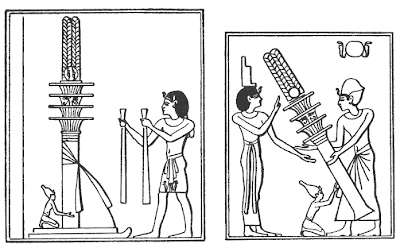 | |
| The colonnade at Saqqara |
The origin and meaning of the classical columnar orders has been debated for centuries, with quite some fanciful ideas tossed about to explain how the Doric, Ionic and Corinthian orders came to be.
This is the first in a series of posts that will re-examine the elements and origins of the classical orders and posit new interpretations of their meanings. But before we look at the classical orders, we should first examine the sacred architecture of the ancient Egyptians, who after all invented the column (not to mention architecture itself), and who were also the source and wellspring for high learning in the Classical world.
The first historical architect (and also engineer and physician) is Imhotep ("he who comes in peace"), one of the greatest intellects ever to walk the earth. Imhotep (2635-2595 B.C.) served as chancellor to the Third Dynasty Pharaoh Djozer and was high priest of the sun god Ra at On, better known by its Greek name of Heliopsis, "city of the sun." He was also a poet and philosopher and one of the few non-Pharaohs in the long history of Egypt ever to be depicted in stone. Eventually, 1400 years after his death, he was deified.
 |
| The stepped Pyramid of Djozer at Saqqara |
In traditional Egyptology (though the simple existence of the Osirion at Abydos, as well as the advanced erosion of the Great Sphinx and Valley Temples at Giza should give one great pause in blindly accepting the conventional, increasingly untenable chronology), Imhotep is credited with the first systematic use of dressed stone construction, embodied in the design and construction of Djozer's stepped pyramid and temple complex at Saqqara from 2630 to 2611 BCE, and the invention of the column is often attributed to him as well. An altogether astounding personage.
 |
| The ceremony of raising the Djed pillar |
The concept of the column is ultimately traceable to the Djed pillar, a truly ancient phallic fertility symbol depicting the base of the spine of Osiris (and also that of a bull, or Taurus). The ceremony of the raising of the Djed was a festival of fertility and renewal (Djedu was the Egyptian name for Busiris, a center of cult worship for the Pharaoh, and many pharaohs, Djozer among them, bore the title of Djed among their honorifics).
It is also I suspect the origin of the phrase "raising the dead" and the traditional English wordplay of confounding death with ejaculation. For example, Shakespeare was quite fond of the phrase "I die in your lap," which appears both in Hamlet and Much Ado about Nothing ("nothing" also refers to a woman's sexual organs). This use of double entendre, homonyms and multiple meanings in language and literature has always been an important element of occult and esoteric knowledge. Philology and etymology are rife with such resonant convergences; to give but one well-known example, right and left: right comes from the root reg- and means good, straight, righteous, royal and wise. Then there are write and rite, right? Left derives from the Old English lyft, foolish or weak, and ultimately from OE slinken, to crawl (like a snake). Left in German is links and sinister in Latin, the English synonym for evil.
Now that we've dealt with how Shakespeare entertained the groundlings, let us consider the surprise of surprises: columns are ultimately phallic symbols. Who ever would have guessed? To underscore the fertility symbolism, even the earliest columns were depicted with abstracted vegetal motifs. Though much of the architecture of Saqqara is remarkably modern in its abstract geometry and volumetric lucidity, its columns are among the few elements that incorporate recognizable decoration, all of it vegetal in inspiration.
 | |
| A frieze of Djed pillars a Saqqara |
 | |
| Saqqara, the colonnade |
 |
| Engaged columns with lotus flower capitals at the Jubilee or Heb Sed Court at Saqqara |
The convex fluting of the majestic colonnade at Saqqara, one of the most beautiful spaces in all of Egypt, abstracts bundled papyrus stalks and in Egyptian cosmology the papyrus, along with the lotus flower that gives its form to so many Egyptian capitals, was found at the primordial mound at the beginning of time. Papyrus stalks held up the arching goddess Nut, the sky, just as the lotus flower opened to give birth to the sun. The papyrus also symbolized Lower Egypt, while the lotus represented Upper Egypt; thus the two main symbols incorporated into the columns that held up the roof or sky of Egyptian temples also symbolically united the Two Lands of Egypt itself and encapsulated the origins of the universe. As above, so below.
 |
| Nut the sky goddess arching over her lover Geb, the earth god; note the Djed pillar at left, found just beneath an Ankh |
But we should not stop there. The papyrus is also the source of paper and thus also a cipher for knowledge and for civilization itself, the pillar or spine of consciousness which holds up the vault of Heaven which shelters man.
 |
| Isis stands at far right, bearing a papyrus staff indicating her divine stature, from Kom-Ombo |
 |
| The Egyptian lotus, or blue water lily (Nymphaea Caerulea) |
 |
| The great hall of Amun-Re at the temple complex of Karnak, ancient Thebes |
As above, so below.
Coming soon, the Doric order.

I always enjoy both the informative side of your post & the beauty of the images you select to visually narrate the point. Very interesting indeed.
ReplyDeleteI did not know that I could learn so much in such a short time. You want to a great deal of effort to put all that information together. I surely do appreciate it. Ann
ReplyDelete